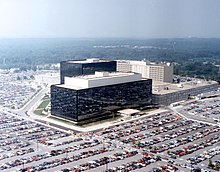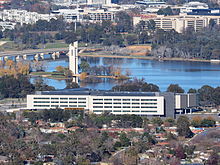
Back Five Eyes AF خمس أعين Arabic Пет очи Bulgarian ফাইভ আইস Bengali/Bangla Five Eyes Czech Cinco Ojos Spanish فایو آیز FA Five Eyes French חמש העיניים HE फाइव आइज HI
Five Eyes | |
|---|---|
 Members shown in blue | |
| Working language | English |
| Type | Intelligence alliance |
| Members | |
| Establishment | |
| August 14, 1941 | |
| May 17, 1943 | |





The Five Eyes (FVEY) is an Anglosphere intelligence alliance comprising Australia, Canada, New Zealand, the United Kingdom, and the United States.[1] These countries are parties to the multilateral UK-USA Agreement, a treaty for joint cooperation in signals intelligence.[2][3][4] Informally, Five Eyes can also refer to the group of intelligence agencies of these countries.
The origins of the FVEY can be traced to informal secret meetings during World War II between British and American code-breakers, which started before the US formally entered the war, followed by the Allies' 1941 Atlantic Charter that established their vision of the post-war world. Canadian academic Srdjan Vucetic argues the alliance emerged from Winston Churchill's Iron Curtain speech in 1946,[5] which warned of open conflict with the Soviet bloc unless the Anglosphere democracies learned to cooperate:
Neither the sure prevention of war, nor the continuous rise of world organisation will be gained without what I have called the fraternal association of the English-speaking peoples. This means a special relationship between the British Commonwealth and Empire and the United States... the continuance of the intimate relationship between our military advisers, leading to common study of potential dangers...[6]
As the Cold War deepened, the intelligence sharing arrangement became formalised under the ECHELON surveillance system in the 1960s.[7] This was initially developed by the FVEY to monitor the communications of the former Soviet Union and the Eastern Bloc, although it is now used to monitor communications worldwide.[8][9]
In the late 1990s, the existence of ECHELON was disclosed to the public, triggering a major debate in the European Parliament and, to a lesser extent, the United States Congress and the British Parliament. The FVEY further expanded their surveillance capabilities during the course of the "war on terror", with much emphasis placed on monitoring the World Wide Web. Former NSA contractor Edward Snowden described the Five Eyes as a "supra-national intelligence organisation that does not answer to the known laws of its own countries".[10] Documents leaked by Snowden in 2013 revealed that the FVEY has been spying on one another's citizens and sharing the collected information with each other, although the FVEY nations maintain that this was done legally. It has been claimed that FVEY nations have been sharing intelligence in order to circumvent domestic laws, but only one court case in Canada has found any FVEY nation breaking domestic laws when sharing intelligence with a FVEYs partner.[11][12][13][14]
In spite of continued controversy over its methods, the Five Eyes relationship remains one of the most comprehensive known espionage alliances in human history.[15]
Since processed intelligence is gathered from multiple sources, the intelligence shared is not restricted to signals intelligence (SIGINT) and often involves defence intelligence as well as human intelligence (HUMINT) and geospatial intelligence (GEOINT).
- ^ "Five Eyes Intelligence Oversight and Review Council (FIORC)". www.dni.gov.
- ^ Cox, James (December 2012). "Canada and the Five Eyes Intelligence Community" (PDF). Canadian Defence and Foreign Affairs Institute. Archived from the original (PDF) on 10 September 2015. Retrieved 24 July 2016.
- ^ "Five Eyes". United States Army Combined Arms Center. Archived from the original on 2 February 2014. Retrieved 18 January 2014.
- ^ "PKI Interoperability with FVEY Partner Nations on the NIPRNet". United States Department of the Navy. Archived from the original on 1 February 2014. Retrieved 18 January 2014.
- ^ "CANZUK anyone?". Diplomat Magazine. Retrieved 8 March 2021.
- ^ "The Sinews of Peace ('Iron Curtain Speech')". International Churchill Society. 5 March 1946. Retrieved 8 March 2021.
- ^ "Five Eyes and the Perils of an Asymmetric Alliance – AIIA". Australian Institute of International Affairs. Retrieved 8 March 2021.
- ^ Asser, Martin (6 July 2000). "Echelon: Big brother without a cause?". BBC News. Archived from the original on 25 January 2014. Retrieved 28 January 2014.
- ^ "Q&A: What you need to know about Echelon". BBC News. 29 May 2001. Archived from the original on 18 December 2013. Retrieved 28 January 2014.
- ^ Cite error: The named reference
ndrwas invoked but never defined (see the help page). - ^ Cite error: The named reference
guardian1was invoked but never defined (see the help page). - ^ Cite error: The named reference
guardian2was invoked but never defined (see the help page). - ^ Cite error: The named reference
guardian3was invoked but never defined (see the help page). - ^ Cite error: The named reference
reuters1was invoked but never defined (see the help page). - ^ Perry, Nick (16 July 2013). "Experts say US spy alliance will survive Snowden". Yahoo! News. Associated Press. Archived from the original on 27 June 2015. Retrieved 25 June 2015.